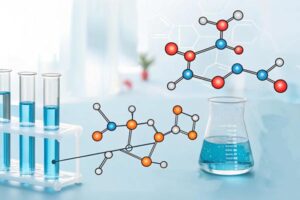Lubricants play an indispensable role in various mechanical equipment, ensuring the smooth operation of components like engines, gears, and bearings, reducing friction and wear, and thereby extending the lifespan of the equipment. However, lubricants themselves are not simple chemical compounds; they are complex mixtures comprising base oils and various additives. Among these components, additives are the true “magical” ingredients that impart various characteristics to lubricants, from antioxidation to acid neutralization, catering to the needs of diverse mechanical equipment.
Although additives make up a relatively small proportion of lubricants, their role is of paramount importance. Lubricant additives come in various types, each serving a distinct purpose to address different working conditions and challenges. Here, we’ll delve into some common lubricant additives, including acid neutralizers such as carbodiimides.

Antioxidants:
Mechanical equipment often operates in high-temperature environments, leading to lubricant oxidation and the formation of acidic substances, which accelerate equipment corrosion. Antioxidants enhance the oxidation stability of lubricants, delaying the oxidation process. They also create an anti-wear film on metal surfaces, isolating corrosive substances and safeguarding equipment from damage.
Lubricity and Extreme Pressure Antiwear Additives:
Friction and wear are common issues during equipment operation, and prolonged friction can decrease equipment lifespan and performance. Lubricity additives contain polar molecules that can form adsorption films on friction surfaces, reducing friction and minimizing wear. Extreme pressure antiwear additives, on the other hand, contain substances like sulfur, phosphorus, and chlorine. These substances react chemically with metals, forming protective films at high temperatures, high loads, or high-speed conditions, preventing surface damage and enhancing load-bearing capacity.
Pour Point Depressants:
As mechanical equipment advances, lubricants must adapt to a wider range of temperatures. Pour point depressants are used to enhance the fluidity of lubricants at low temperatures, ensuring that equipment functions smoothly even in frigid conditions.
Viscosity Index Improvers:
Viscosity is a key parameter for lubricant performance, and it varies with temperature. Viscosity index improvers are used to adjust the temperature-dependent viscosity properties of lubricants, allowing them to maintain stable performance at different temperatures.
Rust and Corrosion Inhibitors:
Rust is a common problem for metal components. Lubricants contain rust inhibitors that can create molecular protective layers on metal surfaces, preventing corrosion caused by water, humidity, and air.
Acid Scavenger
Acid scavengers are additives used to neutralize or reduce the acidic substance content in lubricants, preventing corrosion of equipment and engine components. These acid scavengers come in various types, including:
Carbodiimides: Carbodiimides are a common type of acid neutralizer. They can increase the Total Base Number (TBN) of lubricants, neutralizing acidic components and extending the lubricant’s service life. Carbodiimides are often used in synthetic oils to meet the demands of high-performance engines and equipment.
What is carbodiimide?
Phosphate Esters: Phosphate esters are effective acid scavengers typically used in high-temperature and high-pressure applications, such as turbocharged engines. They not only neutralize acidic substances but also exhibit outstanding antioxidation properties.
Calcium Peroxide: Calcium peroxide is an alkaline acid neutralizer used to neutralize acidic components in lubricants, protecting equipment from corrosion. It finds widespread use in diesel engines and lubricants.
Phosphoric Esters: Phosphoric esters are Acid scavengers suitable for diesel engines and high-temperature, high-pressure applications. They neutralize acidic substances and provide additional anti-wear protection.
Calcium Peroxide-Phosphoric Esters Blends: These blends combine the properties of calcium peroxide and phosphoric esters to offer comprehensive acid neutralization and antioxidation protection.
Sodium Peroxide: Sodium peroxide is an acid neutralizer with alkaline properties, capable of neutralizing acidic substances in lubricants.
Each type of acid neutralizer has specific applications and performance advantages. Lubricant manufacturers typically use one or more of these Acid scavengers in their products to meet the requirements of different mechanical equipment. Choosing the right acid neutralizer is crucial for the long-term reliability of equipment, ensuring that it operates smoothly even under harsh working conditions.
In summary, lubricant additives are essential components for enhancing lubricant performance, ensuring the smooth operation and long-term reliability of mechanical equipment. By selecting the appropriate additive types and proportions, lubricant manufacturers can tailor the properties of lubricants to meet the needs of various applications, providing optimal lubrication and protection for mechanical equipment.







